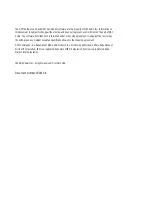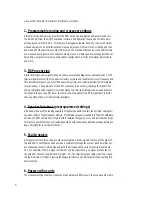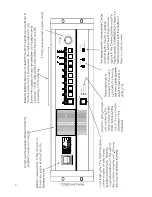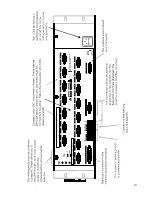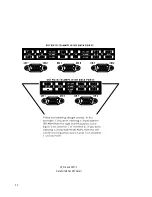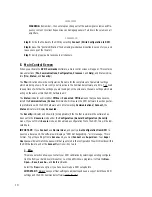
wires within the cable for maximum interference protection.
2. Programmable routing and crossover settings
Almost all of the internal circuitry within the DCM series can be adjusted using commands over
the RS-232 port from the DCM Commander software. Configuration files can be stored to a dis-
kette and used for other DCMs. For example, if a megaplex theater has many rooms with similar
size and equipment, an installation technician can adjust one DCM unit for best results, and then
download all of these settings to other DCM units. The functions that can be controlled remotely
are: crossover settings for screen channel outputs, mutes, multiple equalizer settings per channel,
delay times, output volume levels, some channel assignments, monitor mix balance adjustments,
and more.
3. DSP processing
Digital filtering of audio signals is known to have several advantages over analog solutions. DSP
(digital signal processor) IC chips allow extremely accurate and reliable control over frequency and
time adjustments (boost, cut, cutoff frequency, delay time), and stability (immunity from tempera-
ture variations). The audio path of the DCM uses conversion circuitry (changing the signal from
analog to digital and back again) which is designed to minimize all background noise and react to
the dynamic range of any film track. In other words, the quality of the DCM signal path is better
than any state-of-the-art cinema format available!
4. Speaker Database (preprogrammed settings)
QSC has worked with the leading suppliers of theater speakers to obtain the optimum settings for
the most common theater speaker models. This database is easily loaded into the DCM hardware
unit and the DCM Commander software offers features to organize, store, and edit these settings.
This feature guarantees that your installation starts with technically optimized settings before you
begin adjusting for room characteristics !
5. Fault Analysis
All signals from the film sound processor are compared with the signals that are at the output of
the amplifier to verify that sound has made it completely through the system. Each amplifier out-
put channel has sensors which measure both the voltage and the current to verify proper opera-
tion. For example, if there is signal at the DCM unit input but there is no signal at the output of
the amplifier, then the fault indicator will light. Or, if an amplifier output cable is shorted or open,
the fault indicator will light. Pressing the Diagnostics button will indicate which channel has this
fault condition.
6. Password Security
The crossover settings that you create can make a dramatic difference in the sound quality within
5
Summary of Contents for DCM series
Page 1: ...DCM Series Digital Cinema Monitor Crossover System U S E R M A N U A L...
Page 3: ......
Page 4: ......
Page 14: ...7...
Page 15: ...8...
Page 16: ...9...
Page 17: ...10...
Page 18: ...DCM 2 and DCM 3 DataPort ABC and EF Detail 11...
Page 55: ......
Page 56: ...1675 MacArthur Boulevard Costa Mesa CA 92626 1468...


